18
Santiago Tassara ● Profesor Asistente
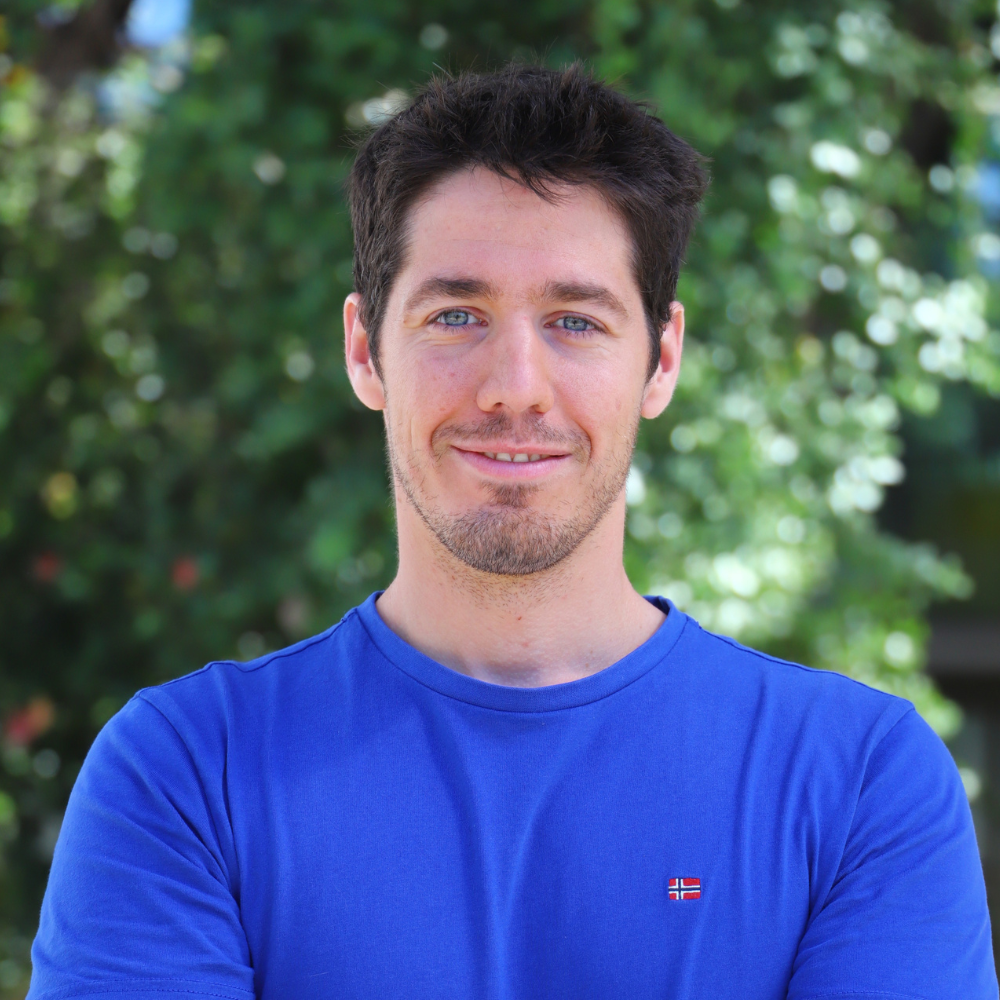
Doctor en Ciencias, Mención Geología; Universidad de Chile
Licenciado en Geología; Universidad Nacional de La Plata, Argentina
Descripción
Santiago Tassara recibió su entrenamiento académico en la Universidad Nacional de La Plata (Argentina), donde obtuvo su Licenciatura en Geología, en la Universidad de Barcelona (España), donde recibió el grado de Máster en Recursos Minerales, y en la Universidad de Chile, donde se graduó como Doctor en Ciencias, Mención Geología. Desde el 2019 hasta el 2022, se desempeñó como “Académico Postdoctoral Bateman” en la Universidad de Yale (EE. UU).
Su investigación busca comprender cómo los metales base y preciosos se concentran en la corteza terrestre formando depósitos minerales. Para esto, Santiago utiliza observaciones de campo en combinación con herramientas mineralógicas y geoquímicas para entender los procesos magmáticos y geodinámicos que controlan el flujo y concentración de elementos formadores de mena durante la evolución y migración de magmas y fluidos hidrotermales en la litosfera terrestre.
4
- REVISTA Geothermics
- 2024
Gas geothermometry, soil CO2 degassing, and heat release estimation to assess the geothermal potential of the Alpehue Hydrothermal Field (Sollipulli volcano, Southern Chile)
• Daniele Tardani • Marco Taussi • Philippe Robidoux • Pablo Sánchez-Alfaro • Pamela Pérez-Flores
- REVISTA Chemical Geology
- 2024
Osmium and oxygen isotope constraints on magma-crust interactions and the transport of copper at the roots of arcs
• Santiago Tassara • Jay J. Ague • Duncan S. Keller • Alan D. Rooney • Jordan A.G. Wostbrock
- REVISTA Communications Earth & Environment
- 2024
The orientation of intra-arc crustal fault systems influences the copper budget of magmatic-hydrothermal fluids
• Daniele Tardani • Santiago Tassara • Pablo Sánchez-Alfaro • Martin Reich • Pamela Pérez-Flores
- REVISTA Nature Geoscience
- 2023
Links between large igneous province volcanism and subducted iron formations
• Duncan S. Keller • Santiago Tassara • Leslie J. Robbins • Cin-Ty A. Lee • Jay J. Ague
- REVISTA Earth-Science Reviews
- 2023
Massive Jurassic slab break-off revealed by a multidisciplinary reappraisal of the Chon Aike silicic large igneous province
• Santiago Tassara • Daniele Tardani
- REVISTA Nature Geoscience
- 2022
Slab-derived devolatilization fluids oxidized by subducted metasedimentary rocks
• Jay J. Ague • Santiago Tassara • Megan E. Holycross • Ji-Lei Li • Elizabeth Cottrell
- REVISTA Geology
- 2022
Osmium isotopes fingerprint mantle controls on the genesis of an epithermal gold province
• Santiago Tassara • Alan D. Rooney • Jay. J. Ague • Diego Guido • Martin Reich
- REVISTA Economic Geology
- 2022
A Role for Crustal Assimilation in the Formation of Copper-Rich Reservoirs at the Base of Continental Arcs
• Santiago Tassara • Jay J. Ague
- REVISTA Geochimica et Cosmochimica Acta
- 2021
Subduction zone sulfur mobilization and redistribution by intraslab fluid-rock interaction
• Ji-Lei Li • Esther M. Schwarzenbach • Timm John • Jay J. Ague • Santiago Tassara
- REVISTA Geology
- 2021
The deep magmatic cumulate roots of the Acadian orogen, eastern North America
• Santiago Tassara • Jay J. Ague • Victor Valencia
- REVISTA Geochimica et Cosmochimica Acta
- 2020
Post-melting oxidation of highly primitive basalts from the southern Andes
• Santiago Tassara • Martin Reich • Claudia Cannatelli • Brian A. Konecke • Dominica Kausel
- REVISTA Nature Communications
- 2020
Fluxing of mantle carbon as a physical agent for metallogenic fertilization of the crust
• Daryl E. Blanks • David A. Holwell • Marco L. Fiorentini • Marilena Moroni • Andrea Giuliani
- REVISTA Frontiers in Earth Science
- 2020
Unraveling the Effects of Melt-Mantle Interactions on the Gold Fertility of Magmas
• Santiago Tassara • Martin Reich • Brian A. Konecke • José María González-Jiménez • Adam C. Simon
- REVISTA Lithos
- 2020
Mineralogy of the HSE in the subcontinental lithospheric mantle –An interpretive review
• Santiago Tassara
- REVISTA Contributions to Mineralogy and Petrology
- 2019
Magmatic platinum nanoparticles in metasomatic silicate glasses and sulfides from Patagonian mantle xenoliths
• José María González-Jiménez • Josep Roqué-Rosell • Abigail Jiménez-Franco • Santiago Tassara • Fernando Nieto
- REVISTA Lithos
- 2018
Highly siderophile elements mobility in the subcontinental lithospheric mantle beneath southern Patagonia
• Santiago Tassara • José M. González-Jiménez • Martin Reich • Edward Saunders • Ambre Luguet
- REVISTA Nature Communications
- 2017
Plume-subduction interaction forms large auriferous provinces
• Santiago Tassara • José M. González-Jiménez • Martin Reich • Manuel E. Schilling • Diego Morata
- REVISTA Mineralium Deposita
- 2016
Fe-Ni-bearing serpentines from the saprolite horizon of Caribbean Ni-laterite deposits: new insights from thermodynamic calculations
• Santiago Tassara
- 1241146
- Abril 2025 - Marzo 2028
Determination of magma fertility and sulfide saturation for giant porphyry copper deposits in central Chile: A platinum-group element perspective
- 11240035
- Marzo 2024 - Abril 2027
Tracing the links between the volatile composition and oxygen fugacity of magmas, their ore fertility, and crustal thickness: A regional scale investigation of the Miocene to Mio-Pliocene arc segment of the Andes of central Chile
- 1241146
- Marzo 2024 - Marzo 2028
Magmatic and Metallogenic Evolution of the MaricungaEl Indio Belt
- EQM230002
- Diciembre 2023 - Septiembre 2024
santiago.tassara@uoh.cl
Stefan Escaida ● Profesor Asistente
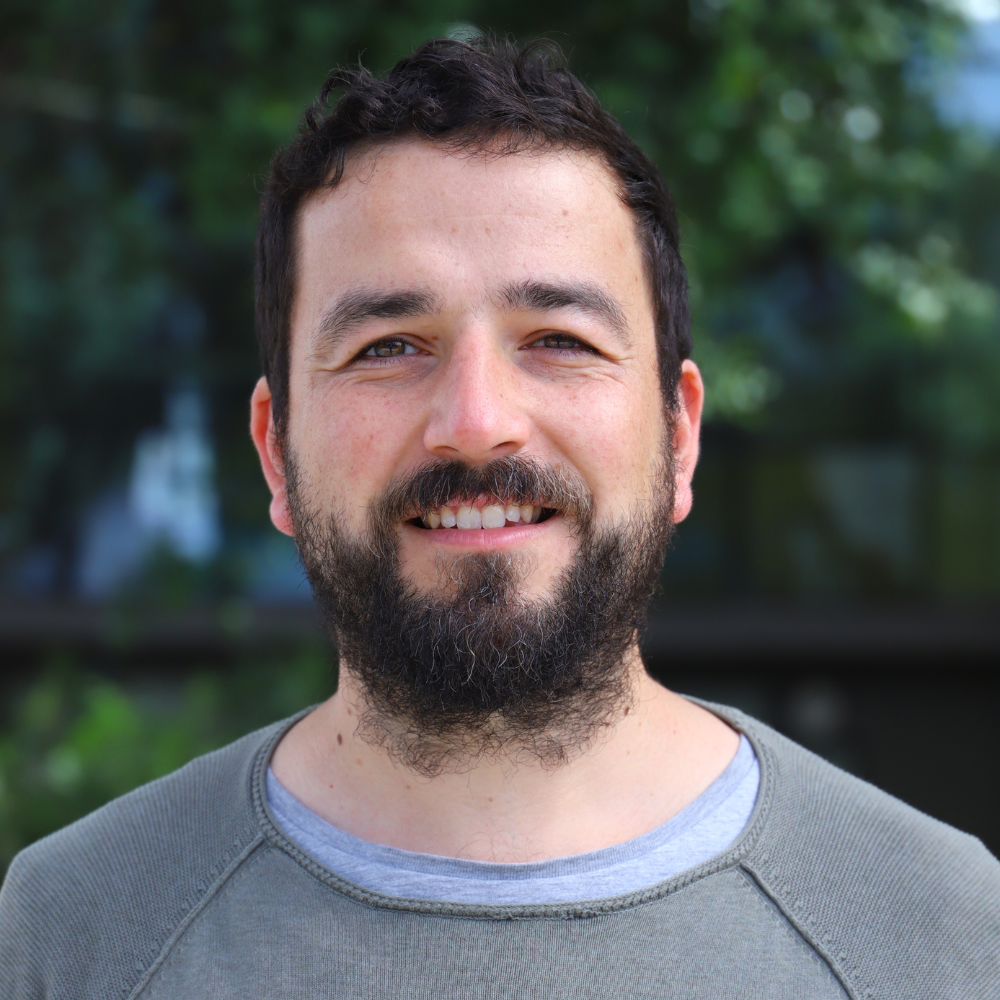
Doktor der Ingenieurswissenschaften (Dr.-Ing.), 2016, Karlsruhe Institute of Technology, Alemania
Diplom-Informatiker (Dipl.-Inform.), 2010, Karlsruhe Institute of Technology, Alemania
Descripción
Stefan Escaida recibió su título de Informático (Dipl.-Inform.) y su doctorado (Dr.-Ing.) en robótica del Karlsruhe Institute of Technology en 2010 y 2016 respectivamente. Durante su fase de doctorado investigó en temas como el reconocimiento háptico de objetos, manipulación de objetos, así como también la tecnología y las aplicaciones de sensores capacitivos táctiles y de proximidad. Dentro de las aplicaciones investigadas se encuentran el preajuste de garras, evitamiento de colisiones, teleoperación, etc.
Entre fines del 2017 y el verano del 2022 fue investigador postdoctoral en el laboratorio DEFROST en Inria Lille – Nord Europe en Francia. En este período trabajó en el sensado basado en modelos para Soft Robotics.
Desde octubre 2022 es profesor asistente en la Universidad de O’Higgins y desarrolla investigación en el área de Inteligencia Artificial y Robótica del ICI.
10
7
1
- REVISTA IEEE Robotics and Automation Letters
- 2025
Model-Based Capacitive Touch Sensing in Soft Robotics: Achieving Robust Tactile Interactions for Artistic Applications
• Stefan Raimundo Escaida Lubbemeier
- REVISTA Nonlinear Dynamics
- 2024
Estimating time-varying delays and parametric uncertainties in teleoperated robots
• Rohit Singla • Rodrigo Verschae • Stefan Raimundo Escaida Lubbemeier • Harish Parthasarath
- REVISTA IEEE Transactions on Instrumentation and Measurement
- 2023
Highly Stretchable Additively Manufactured Capacitive Proximity and Tactile Sensors for Soft Robotic Systems
• Stefan Raimundo Escaida Lubbemeier
- REVISTA IEEE Robotics and Automation Letters
- 2023
An Open Source Design Optimization Toolbox Evaluated on a Soft Finger
• Stefan Raimundo Escaida Lubbemeier • Luis Gustavo Molina Chávez
- REVISTA IEEE Robotics and Automation Letters
- 2023
Multi-tap Resistive Sensing and FEM Modeling enables Shape and Force Estimation in Soft Robots
• Stefan Raimundo Escaida Lubbemeier
- REVISTA IEEE Transactions on Medical Robotics and Bionics
- 2021
A Bio-Inspired Active Prostate Phantom for Adaptive Interventions
• Stefan Raimundo Escaida Lubbemeier
- REVISTA IEEE Transactions on Robotics
- 2021
Proximity Perception in Human-Centered Robotics: A Survey on Sensing Systems and Applications
• Stefan Raimundo Escaida Lubbemeier
- REVISTA IEEE Robotics and Automation Letters
- 2020
A Model-Based Sensor Fusion Approach for Force and Shape Estimation in Soft Robotics
• Stefan Raimundo Escaida Lubbemeier
- REVISTA IEEE Robotics and Automation Letters
- 2019
Modeling Novel Soft Mechanosensors Based on Air-Flow Measurements
• Stefan Raimundo Escaida Lubbemeier
- REVISTA at - Automatisierungstechnik
- 2015
Plug & produce by modelling skills and service-oriented orchestration of reconfigurable manufacturing systems
• Stefan Raimundo Escaida Lubbemeier
- 243587898
- Diciembre 2025 - Diciembre 2025
IEEE RAS Technical Education Program
- 243587898
- Marzo 2025 - Junio 2026
MagTecSkin: Novel Tactile Sensitive Electronic Skin based on Magnetic Technology
- 243587898
- Diciembre 2024 - Diciembre 2024
AIJ support grant for organizing the Third Latin American Summer School on Cognitive Robotics
- 243587898
- Diciembre 2024 - Diciembre 2024
IEEE CIS support grant for organizing the Third Latin American Summer School on Robotics
- 243587898
- Noviembre 2024 - Diciembre 2024
KhipuX grant for organizing the Third Latin American Summer School on Cognitive Robotics
- 11230505
- Marzo 2023 - Marzo 2026
A Sensorization Toolbox for the Realization of Soft Physical Twins: Applications to Phantoms of Human Organs
- 243587898
- Junio 2013 - Junio 2017
Methods for Exploration, Manipulation and Safe Human-Robot-Interaction with Capacitive Tactile Proximity Sensors
- 2015
Capacitive Tactile Proximity Sensing: From Signal Processing to Applications in Manipulation and Safe Human-Robot Interaction
stefan.escaida@uoh.cl
Etienne Bresciani ● Investigador Asociado
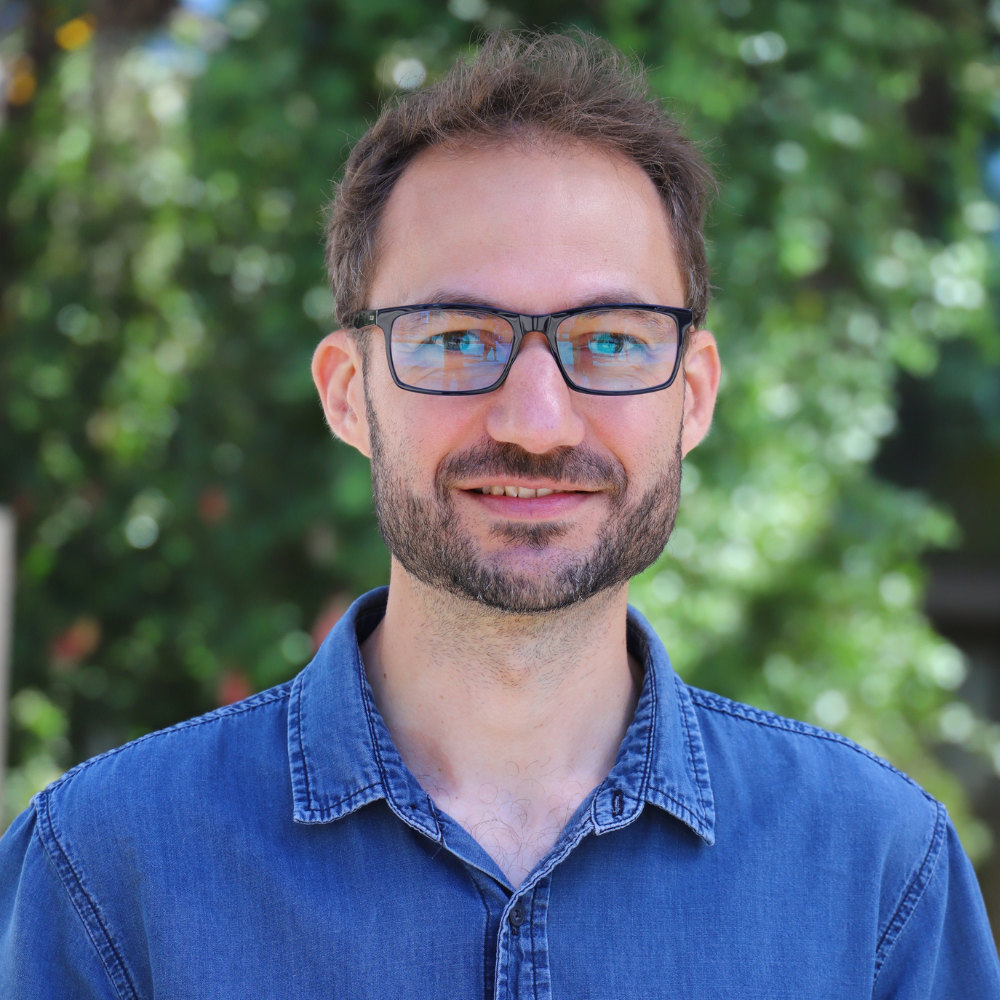
Doctor en Ciencias de la Tierra, Universidad de Rennes, Francia
Ingeniero en Matemáticas y Modelación, Instituto Nacional de Ciencias Aplicadas de Toulouse, Francia
Descripción
Etienne obtuvo el título de Ingeniero en Matemáticas y Modelación del Instituto Nacional de Ciencias Aplicadas de Toulouse (Francia) en 2005 y trabajó como Ingeniero de Investigación durante un año en el Instituto Nacional de Investigación en Informática y Automática (Francia). Luego, se decantó por la hidrogeología a través de un doctorado obtenido en 2011.
Tras cuatro años de postdoctorado en la Universidad Flinders (Australia) y cuatro años de postdoctorado en el Instituto Coreano de Ciencia y Tecnología (Corea del Sur), Etienne se desempeñó como Investigador en el Centro de Estudios Avanzados en Zonas Áridas (Chile) antes de llegar en la Universidad de O’Higgins en 2022.
Etienne se dedica al estudio de la hidrodinámica de las aguas subterráneas, a su modelación matemática y a la evaluación de los recursos hídricos subterráneos. Desarrolla investigación en nuestros Instituto en el área de Geociencias.
8
10
5
- REVISTA Ecological Indicators
- 2025
Comprehensive approach to coastal lagoon ecological health evaluation: Example of Petrel Lagoon, Central Chile
• Morgane Marie Reine Derrien • Celine Lavergne • Polette Aguilar-Muñoz • Yoelvis Sulbarán • María Soledad Pavlov
- REVISTA Journal of Hydrology and Hydromechanics
- 2024
Varied hydrological regime of a semi-arid coastal wetland
• Jaime G. Cuevas • María Valladares • Lucas Glasner • Etienne Bresciani • Paloma Núñez
- REVISTA Environmental Modelling & Software
- 2023
Numerical analysis of seepage faces and subaerial groundwater discharge near waterbodies and on uplands
• Prayas Rath • Etienne Bresciani • Jianting Zhu • Kevin M. Befus
- REVISTA Water Resources Research
- 2023
Emergence of Unstable Focused Flow Induced by Variable-Density Flows in Vertical Fractures
• Hongfan Cao • Seonkyoo Yoon • Zhenyu Xu • Laura J. Pyrak-Nolte • Etienne Bresciani
- REVISTA NSG2021 1st Conference on Hydrogeophysics
- 2021
Geophysical Characterization of Alluvial Aquifers in Plutonic and Volcanic Semi-Arid Andes Using Electromagnetic Methods
• Giulia de Pasquale • Rémi Valois • Etienne Bresciani • Pablo Álvarez Latorre
- REVISTA Geoscientific Model Development
- 2021
GMD perspective: The quest to improve the evaluation of groundwater representation in continental- to global-scale models
• Tom Gleeson • Thorsten Wagener • Petra Döll • Samuel C. Zipper • Charles West
- REVISTA Lecture Notes in Computational Science and Engineering
- 2010
Multi-parametric intensive stochastic simulations for hydrogeology on a computational grid
• Jocelyne Erhel • Jean-Raynald de Dreuzy • Etienne Bresciani
- REVISTA Lecture Notes in Computational Science and Engineering
- 2009
A parallel scientific software for heterogeneous hydrogeoloy
• Jocelyne Erhel • Jean-Raynald de Dreuzy • Anthony Beaudoin • Etienne Bresciani • Damien Tromeur-Dervout
- ECOS210044
- Abril 2022 - Diciembre 2022
Development of geophysical and modeling approaches to support sustainable groundwater management in semi-arid and Mediterranean areas
- 2016H1D3A1908042
- Enero 2022 - Diciembre 2024
Sistema Articulado de Investigación en Cambio Climático y Sustentabilidad de Zonas Costeras de Chile (URO RED21992)
- 243587898
- Enero 2022 - Diciembre 2022
Breaking the current recharge paradigm in Central Chile: a deep borehole for Andean groundwater flows estimation
- URO21992
- Enero 2022 - Diciembre 2022
Sistema articulado de investigación en cambio climático y sustentabilidad de zonas costeras de Chile
- 19-CTIGH-121324-03
- Enero 2021 - Diciembre 2022
Modelo de balance hídrico en acuífero de roca fracturada
- BIP 40014269
- Junio 2020 - Junio 2022
Mapa de reservas de aguas subterráneas en el Limarí
- ID19I10001
- Diciembre 2019 - Febrero 2022
Desarrollo de un modelo 3D de reservas de agua subterránea en una plataforma web para mejorar la toma de decisión durante sequias en el rio Limarí
- BIP 40014348-0
- Junio 2019 - Enero 2022
Piloto de recarga artificial en acuíferos de Elqui
- 2016H1D3A1908042
- Octubre 2016 - Noviembre 2020
Improving aquifer storage and recovery by developing groundwater flow delineation and characterization technology
- W083SMKGW
- Julio 2016 - Diciembre 2016
Development of Adelaide Plains (AP) groundwater model
- Minnesota Environment and Natural Resources Trust Fund
Banking Groundwater A study examining aquifer storage and recovery for groundwater sustainability in Minnesota
- Department of Environment, Water and Natural Resources, Government of South Australia
Further development of the Goyder Institute Adelaide Plains regional groundwater model (AP2017)
- Goyder Institute for Water Research
Assessment of Adelaide Plains Groundwater Resources: Appendices Part II Regional Groundwater Modelling
- Goyder Institute for Water Research
Assessment of Adelaide Plains Groundwater Resources: Appendices Part I Field and Desktop Investigations
- Goyder Institute for Water Research
Assessment of Adelaide Plains Groundwater Resources: Summary Report
etienne.bresciani@uoh.cl
Robert Guamán-Rivera ● Investigador Postdoctoral
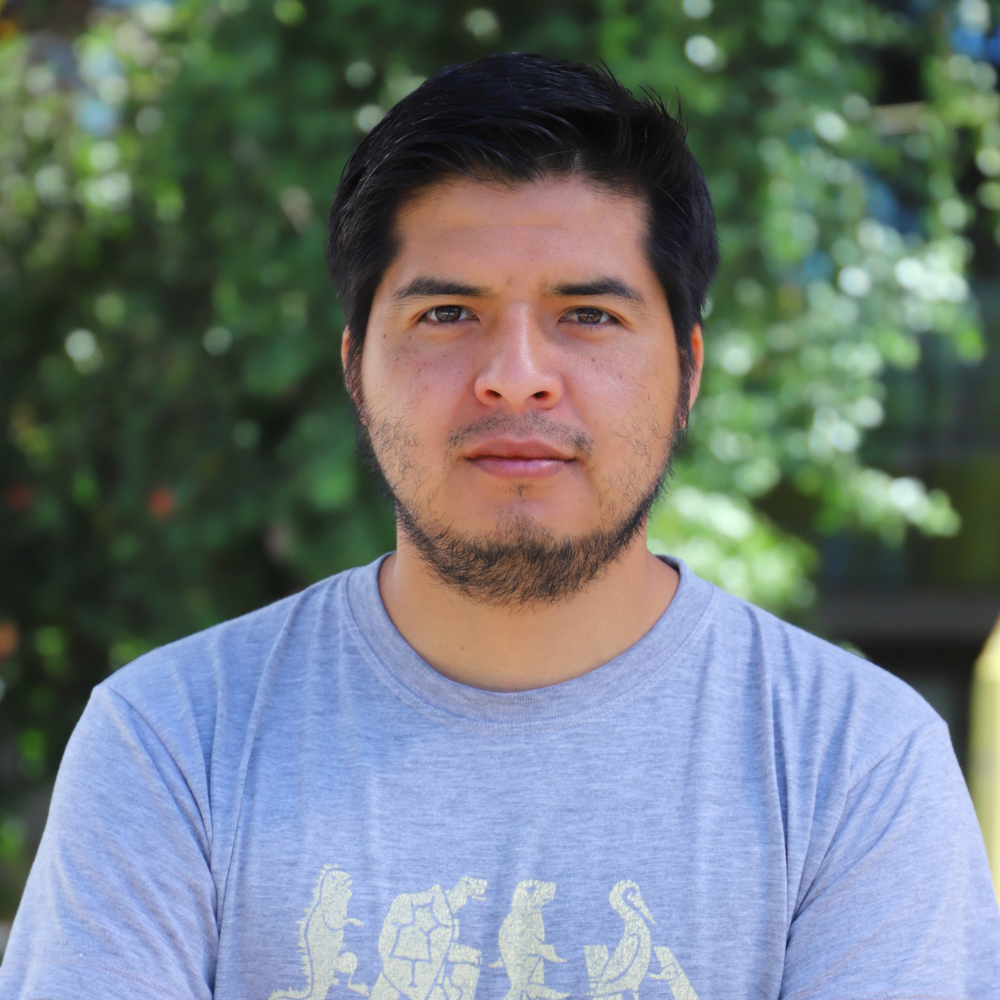
Doctor en Ingeniería Electrónica, Universidad Técnica Federico Santa María
Ingeniero en Electrónica y Control, Universidad Politécnica Nacional, Quito-Ecuador
Descripción
Robert Guamán-Rivera nació en Malacatos-Loja, Ecuador. Se graduó como ingeniero en Electrónica y Control en la Escuela Politécnica Nacional, Quito, Ecuador, en 2016 y recibió el grado de Doctor en Ingeniería Electrónica en la Universidad Técnica Federico Santa María, Valparaíso, Chile, en 2021. Se desempeño como asistente de Investigación en el Laboratorio de Robótica y Sistemas Inteligentes (RISLAB) de la Universidad de O'Higgins, Rancagua- Chile durante el 2021-2022. Actualmente es Postdoctorado en el Instituto de Ciencias de la Ingeniería, Universidad de O’Higgins, Rancagua, Chile. Sus intereses actuales incluyen visión por computadora, tecnologías de sistemas neuromórficos, aprendizaje automático, sistemas de control, robótica, fabricación aditiva (impresión 3D) y agricultura inteligente.
Robert Guamán-Rivera integra el área del Instituto de Inteligencia Artificial y Robótica
6
1
- REVISTA Neurocomputing
- 2025
Event-based optical flow: Method categorisation and review of techniques that leverage deep learning
• Robert Guaman • Jose Delpiano • Rodrigo Verschae
- REVISTA ROBOVIS
- 2024
Color Event-Based Camera Emulator for Robot Vision
• Ignacio Gabriel Bugueño Córdova • Miguel Campusano • Robert Guaman • Rodrigo Verschae
- REVISTA IAARC
- 2024
Assessment of deep learning-based detection algorithms using event cameras for construction applications
• Robert Guaman • Ariel Ignacio Zúñiga Santana • Rodrigo Verschae
- REVISTA Smart Cities
- 2024
Smart Delivery Assignment through Machine Learning and the Hungarian Algorithm
• Juan Pablo Vasconez • Elias Schotborgh • Ingrid Nicole Vásconez • Viviana Moya • Andrea Pilco
- REVISTA 2023 IEEE CHILEAN Conference on Electrical, Electronics Engineering, Information and Communication Technologies (CHILECON)
- 2023
Assessment of Convolutional Neural Networks for Asset Detection in Dynamic Automation Construction Environments
• Robert Guaman • Oswaldo Menéndez • Tito Arevalo-Ramirez • Katherine Aro • Alvaro Prado
- REVISTA Buildings
- 2022
Recent Developments and Challenges of 3D-Printed Construction: A Review of Research Fronts
• Robert Guaman • Alejandro Martínez-Rocamora • Rodrigo García-Alvarado • Claudia Muñoz-Sanguinetti • Luis Felipe González-Böhme
- FONDO DE INVESTIGACIÓN INTERDISCIPLINARIA
- Diciembre 2024 - Diciembre 2026
Construcción de modelos de desarrollo y madurez de cerezas mediante IA y visión computacional 3D a partir de imágenes hiperespectrales
robert.guaman@uoh.cl
María de los Ángeles Rodríguez ● Profesora Asistente
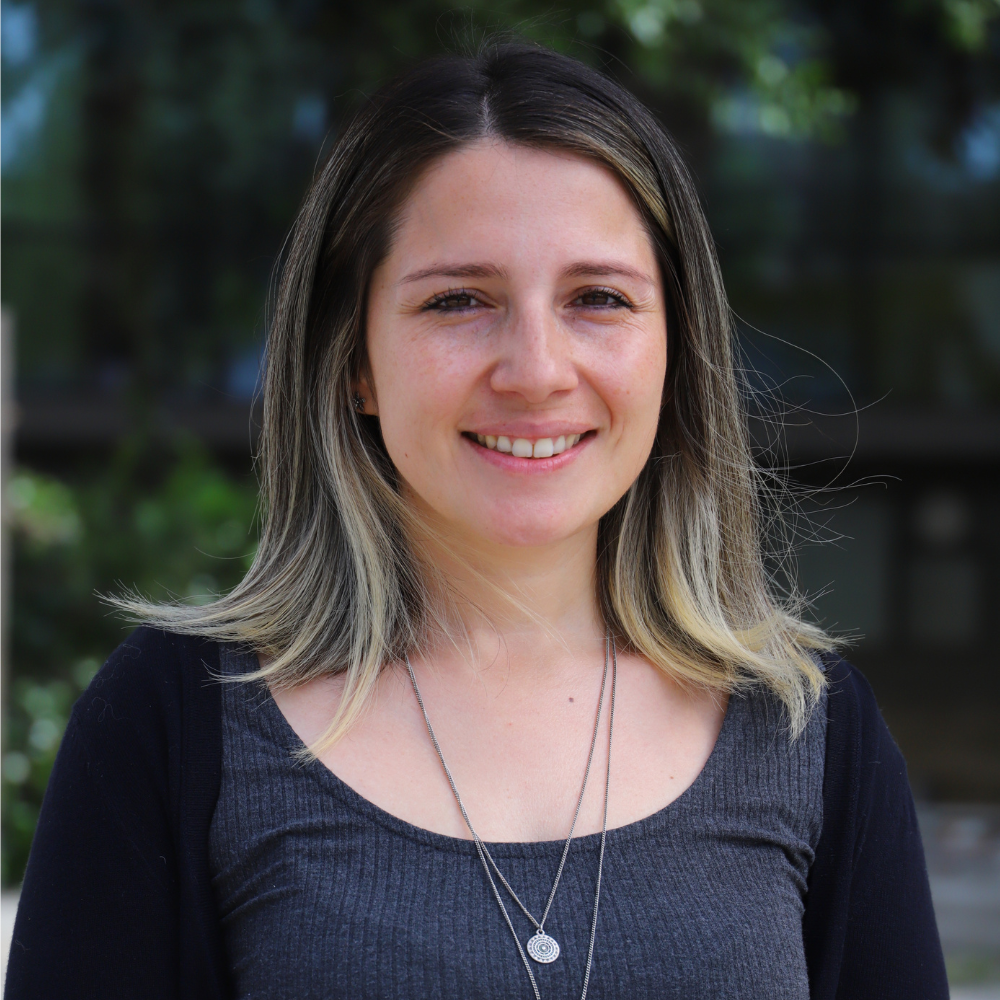
Doctora y Magister en Neurociencias, Pontificia Universidad Católica de Chile.
Licenciada en Ciencias Biológicas, Pontificia Universidad Católica de Chile
Descripción
María de los Angeles es Licenciada en Ciencias Biológicas, Magíster y Doctora en Neurociencias de la Pontificia Universidad Católica de Chile. Su interés se centra en entender cómo el sistema nervioso codifica y procesa la información sensorial proveniente del interior de nuestro cuerpo e influye en cómo percibimos el entorno. Utiliza un enfoque experimental y multidisciplinario combinando perspectivas de las neurociencias cognitivas, psicofísica y ciencias de la computación para entender mecanismos y dinámicas electrofisiológicas, así como también, explorar y diseñar soluciones innovadoras que aborden desafíos que puedan contribuir al bienestar.
Desde agosto 2023 es profesora asistente de la Universidad de O’Higgins y desarrolla su investigación en el área de Inteligencia Artificial y Robótica del Instituto de Ciencias de la Ingeniería.
5
3
- REVISTA Journal of Visualized Experiments
- 2023
A Visuospatial Planning Task Coupled with Eye-Tracker and Electroencephalogram Systems
• María de los Ángeles Rodríguez Soto
- REVISTA Journal of Visualized Experiments
- 2021
An Inescapable Cat Odor Exposure Protocol for Studying Innate and Contextual Threat Conditioning in Rats
• María de los Ángeles Rodríguez Soto
- REVISTA Frontiers in Behavioral Neuroscience
- 2020
Interoceptive Insular Cortex Mediates Both Innate Fear and Contextual Threat Conditioning to Predator Odor
• María de los Ángeles Rodríguez Soto
- REVISTA Journal of Neurophysiology
- 2018
The activity of discrete sets of neurons in the posterior insula correlates with the behavioral expression and extinction of conditioned fear
• María de los Ángeles Rodríguez Soto
- REVISTA Behavioural Brain Research
- 2016
A role for the interoceptive insular cortex in the consolidation of learned fear
• María de los Ángeles Rodríguez Soto
- IDI40059070-0
- Junio 2024 - Diciembre 2026
Transferencia Tecnológica 4.0 para la gestión del riesgo en la cadena de valor de la cereza
- 1230762
- Marzo 2023 - Marzo 2026
Interoceptive processing in auditory perception: a study to examine brain-body interactions.
- 1230762
- Enero 2022 - Junio 2023
Understanding the cardioceptive processing in the auditory perception: A EEG study
maria.rodriguez@uoh.cl
Daniele Tardani ● Profesor Asociado
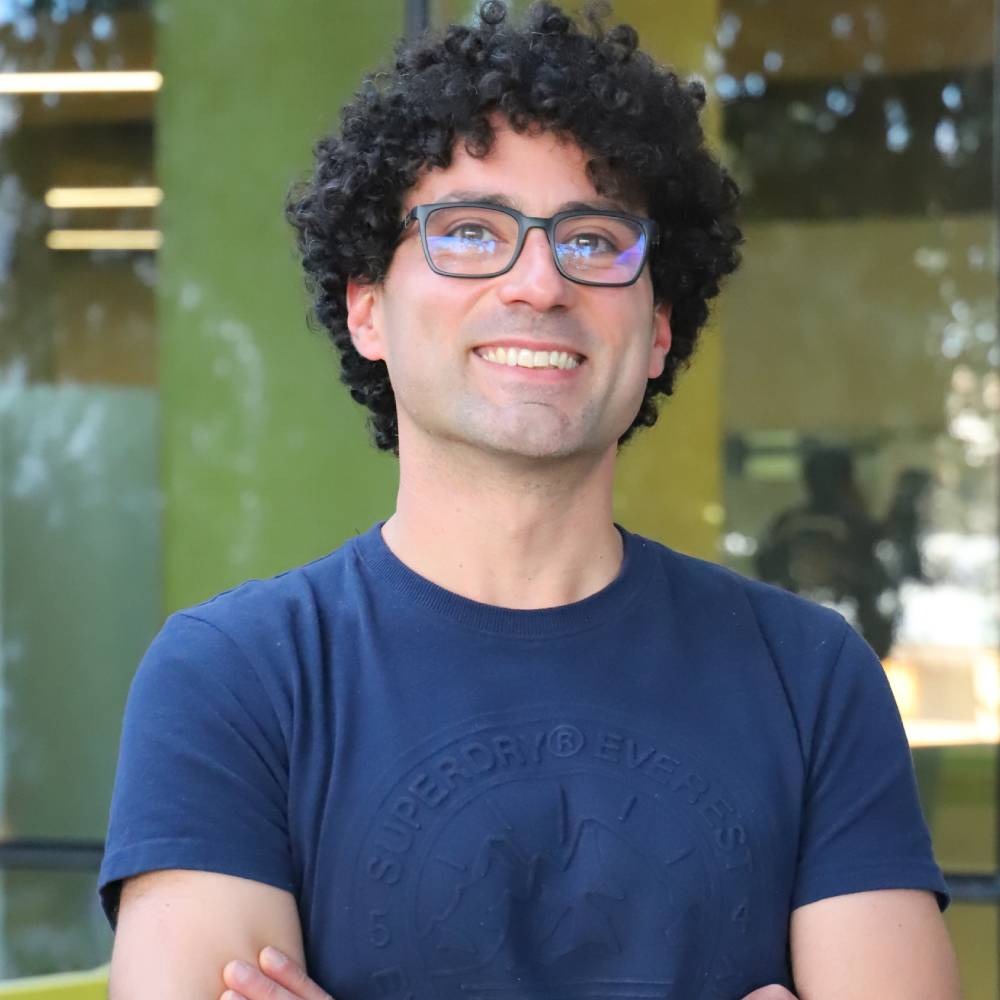
Doctorado en Ciencias, mención Geología (2016), Universidad de Chile
Título de Geólogo (2008), Universitá degli Studi di Firenze, Italia
Descripción
Daniele is a Geologist from the University of Florence and PhD in Science, mention Geology from the Universidad de Chile. In recent years he has worked in academia and in private consulting company, leading research and applied project about hydrothermal fluid circulation and trace metals transport in the upper crust and the geochemistry of soils and wáter pollution.
6
6
1
- REVISTA Geothermics
- 2024
Gas geothermometry, soil CO2 degassing, and heat release estimation to assess the geothermal potential of the Alpehue Hydrothermal Field (Sollipulli volcano, Southern Chile)
• Daniele Tardani • Marco Taussi • Philippe Robidoux • Pablo Sánchez-Alfaro • Pamela Pérez-Flores
- REVISTA Chemical Geology
- 2024
Osmium and oxygen isotope constraints on magma-crust interactions and the transport of copper at the roots of arcs
• Santiago Tassara • Jay J. Ague • Duncan S. Keller • Alan D. Rooney • Jordan A.G. Wostbrock
- REVISTA Communications Earth & Environment
- 2024
The orientation of intra-arc crustal fault systems influences the copper budget of magmatic-hydrothermal fluids
• Daniele Tardani • Santiago Tassara • Pablo Sánchez-Alfaro • Martin Reich • Pamela Pérez-Flores
- REVISTA Environmental Geochemistry and Health
- 2023
Evaluating the geogenic and anthropogenic inputs on the distribution of potentially toxic elements in urban soils of Valdivia, Chile.
• Daniele Tardani • Francisca Vera • Fernanda ÁLVAREZ-AMADO • Violeta Tolorza • Domingo Jullian Fabres
- REVISTA Earth-Science Reviews
- 2023
Massive Jurassic slab break-off revealed by a multidisciplinary reappraisal of the Chon Aike silicic large igneous province
• Santiago Tassara • Daniele Tardani
- REVISTA Chemical Geology
- 2018
Multi-element isotopic evolution of magmatic rocks from Caviahue-Copahue Volcanic Complex (Chile-Argentina): Involvement of mature slab recycled materials
• Daniele Tardani
- 1324000
- Diciembre 2024 - Noviembre 2028
Natural Hydrogen in Chile: Unlocking the Geological Sources for a Green Energy Transition
- ATE220029
- Octubre 2024 - Septiembre 2027
Spatiotemporal dynamics of lithium in Andean salars: Insights for Sustainable Exploration and Exploitation
- FIC IDI40048418-0
- Junio 2023 - Junio 2025
Energías renovables para producción de Sal de Cáhuil
- ATE220029
- Noviembre 2022 - Noviembre 2025
Water energy food nexus for urban areas of central chile(wef-chile)
- 11220777
- Marzo 2022 - Marzo 2025
Structural control on residence times and metal sources in geothermal waters from Southern Andes: implications for geothermal systems and epithermal deposits formation
- FIC IDI40048418-0
- Enero 2022 - Diciembre 2022
Breaking the current recharge paradigm in Central Chile: a deep borehole for Andean groundwater flows estimation
- 2019
The Last Eighteen Years (19982014) of Fumarolic Degassing at the Poás Volcano (Costa Rica) and Renewal Activity
daniele.tardani@uoh.cl
David Salas Videla ● Director / Profesor Asociado
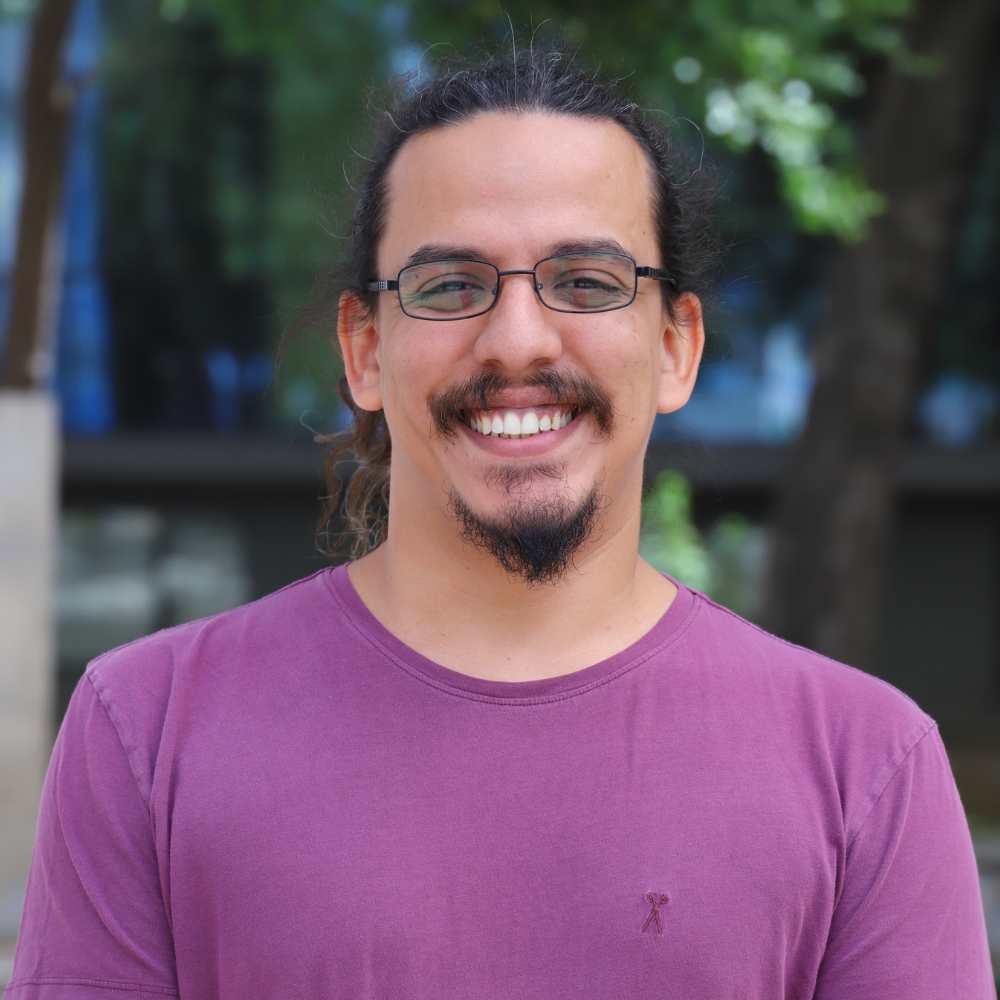
Matemáticas y Modelamiento, Université de Montpellier, Francia
Ingeniero Civil Matemático, Universidad de Chile
Descripción
David Salas realizó sus estudios de pregrado en la Facultad de Ciencias Físicas y Matemáticas de la Universidad de Chile. Posteriormente, hizo sus estudios doctorales en la Universidad de Montpellier (Francia) bajo la dirección de Lionel Thibault. Su tesis doctoral trató de diferentes problemáticas de geometría en espacios de dimensión infinita. Realizó dos años de post-doctorado en el laboratorio PROMES de la Universidad de Perpignan (Francia), donde realizó investigaciones relacionadas con teoría de juegos, energías renovables y uso eficiente de recursos naturales. Cuenta con varias publicaciones ISI en diversas áreas de la matemática, tanto teóricas como aplicadas.
27
11
- REVISTA Transportation Research Part C: Emerging Technologies
- 2025
Idle wage as a tool to regulate the relationship between ride-hailing platforms and drivers
• Andrés Fielbaum • David Sebastián Salas Videla • Ruilin Zhang • Francisco Castro
- REVISTA Journal of Energy Storage
- 2024
Multidimensional analysis for the techno-economic study of the CSP plant
• Daniel Lasluisa • David Sebastián Salas Videla • Nathalie Mazet • Didier Aussel
- REVISTA Mathematische Zeitschrift
- 2024
Metric compatibility and determination in complete metric spaces
• Aris Daniilidis • Tri Minh Le • David Sebastián Salas Videla
- REVISTA Mathematical Programming
- 2024
Exploiting the polyhedral geometry of stochastic linear bilevel programming
• Gonzalo Ignacio Muñoz Martínez • David Sebastián Salas Videla • Anton Kristoffer Svensson Graan
- REVISTA Mathematical Programming
- 2024
A slope generalization of Attouch theorem
• Aris Daniilidis • David Sebastián Salas Videla • Sebastián Tapia-García
- REVISTA Set-Valued and Variational Analysis
- 2024
Steepest Geometric Descent for Regularized Quasiconvex Functions
• David Sebastián Salas Videla • Aris Daniilidis
- REVISTA Journal of Functional Analysis
- 2024
Descent modulus and applications
• Aris Daniilidis • Laurent Miclo • David Sebastián Salas Videla
- REVISTA SIAM Journal on Optimization
- 2023
Existence of solutions for deterministic bilevel games under a general Bayesian approach
• David Sebastián Salas Videla • Anton Kristoffer Svensson Graan
- REVISTA Energy Economics
- 2023
Optimal design of exchange water networks with control inputs in Eco-Industrial Parks
• Didier Aussel • Kien Cao Van • David Sebastián Salas Videla
- REVISTA Integer Programming and Combinatorial Optimization
- 2023
Exploiting the Polyhedral Geometry of Stochastic Linear Bilevel Programming
• Gonzalo Muñoz • David Sebastián Salas Videla • Anton Kristoffer Svensson Graan
- REVISTA Computers & Chemical Engineering
- 2023
Robustness in optimal design of Eco-Industrial Parks under the lens of two-stage stochastic optimization
• Gianfranco Liberona Henriquez • Alessandro Di Pretoro • Stéphane Negny • Ludovic Montastruc • David Sebastián Salas Videla
- REVISTA Computational Management Science
- 2023
The Value of Shared Information for allocation of drivers in ride-hailing: a proof-of-concept study
• Gianfranco Liberona Henriquez • David Sebastián Salas Videla • Léonard von Niederhaüsern
- REVISTA Proceedings of the American Mathematical Society
- 2022
Determination of functions by metric slopes
• Aris Daniilidis • David Sebastián Salas Videla
- REVISTA Journal of Mathematical Analysis and Applications
- 2021
Quantitative characterizations of nonconvex bodies with smooth boundaries in Hilbert spaces via the metric projection
• David Sebastián Salas Videla • Lionel Thibault
- REVISTA SIAM J. Optimization
- 2021
Existence results for Generalized Nash Equilibrium Problems under continuity-like properties of sublevel sets
• Didier Aussel • Kien Cao Van • David Sebastián Salas Videla
- REVISTA Energies
- 2021
Innovative Application of Model-Based Predictive Control for Low-Voltage Power Distribution Grids with Significant Distributed Generation
• Nouha Dkhili • David Sebastián Salas Videla • Julien Eynard • Stéphane Thil • Stéphane Grieu
- REVISTA Mathematical Programming
- 2020
Determination of convex functions via subgradients of minimal norm
• Pedro Pérez Aros • David Sebastián Salas Videla • Emilio José Vilches Gutiérrez
- REVISTA Computers & Chemical Engineering
- 2020
Optimal design of exchange networks with blind inputs and its application to Eco-industrial parks
• David Sebastián Salas Videla • Kien Cao Van • Didier Aussel • Ludovic Montastruc
- REVISTA IFAC-PapersOnLine
- 2020
An Application of Model-based Predictive Control for Renewables-intensive Power Distribution Grids
• Nouha Dkhili • David Sebastián Salas Videla • Julien Eynard • Stéphane Thil • Stéphane Grieu
- REVISTA J. Convex Anal.
- 2020
On formulae for the Ioffe geometric subdifferential of supremum function
• Pedro Pérez Aros • David Sebastián Salas Videla • Emilio José Vilches Gutiérrez
- REVISTA SIAM Journal on Optimization
- 2019
Quasi-Variational Inequality Problems over Product Sets with Quasi-monotone Operators
• Didier Aussel • Kien Cao Van • David Sebastián Salas Videla
- REVISTA Discrete & Continuous Dynamical Systems - A
- 2019
On smoothness of solutions to projected differential equations
• David Sebastián Salas Videla • Lionel Thibault • Emilio José Vilches Gutiérrez
- REVISTA Energy Conversion and Management
- 2018
Economical optimization of thermochemical storage in concentrated solar power plants via pre-scenarios
• David Sebastián Salas Videla • Emeric Tapachès • Nathalie Mazet • Didier Aussel
- REVISTA Journal of Mathematical Analysis and Applications
- 2018
Smoothness of the metric projection onto nonconvex bodies in Hilbert spaces
• Rafael Correa • David Sebastián Salas Videla • Lionel Thibault
- REVISTA Studia Mathematica
- 2018
Convex smooth-like properties and Faces Radon-Nikodým property in Banach spaces
• David Sebastián Salas Videla
- REVISTA Topology and its Applications
- 2016
Extended seminorms and extended topological vector spaces
• David Sebastián Salas Videla • Sebastián Tapia-García
- REVISTA Journal of Convex Analysis
- 2016
Integration of Nonconvex Epi-Pointed Functions in Locally Convex Spaces
• Rafael Correa • David Sebastián Salas Videla • Lionel Thibault
- 1251159
- Abril 2025
Slope-based Variational Analysis and Optimization
- 23-MATH-13
- Junio 2024 - Abril 2024
TRANSFERENCIA SUPERCOMPUTACIÓN PARA INNOVACIÓN EN SALUD REGIONAL: HPC-UOH Y HRLBO
- 23-MATH-13
- Mayo 2024 - Abril 2024
SOGGA: Stochastic Optimization, Generalized Games and Applications
- 3210735
- Abril 2024 - Abril 2024
Stochastic optimization, generalized games and applications
- 11220586
- Marzo 2022 - Marzo 2025
Optimization and games with decision-dependent uncertainty: Theory, Algorithms and Applications
- PRONEX
- Marzo 2022 - Diciembre 2029
Centro de Modelamiento Matemático
- PRONEX
- Julio 2021 - Julio 2023
Gestión Inteligente de Recursos Hídricos para la Agricultura
- PRONEX
- Abril 2021 - Julio 2023
Stochasticity aspects in bilevel games and applications to water resource management
- PRONEX
- Enero 2020 - Diciembre 2021
Stochastic Optimization and Chance Constraints with Applications to Energy (SOCCAE)
- 3190229
- Marzo 2019 - Marzo 2022
Nonsmooth dynamical system involving regular structures
david.salas@uoh.cl
Víctor Bucarey ● Profesor Asistente

Doctor en Sistemas de Ingenieria, Universidad de Chile
Ingeniero Civil Industrial
Descripción
Víctor Bucarey es Ingeniero Civil Industrial, con un doctorado en Sistemas de Ingeniería de la Universidad de Chile. Actualmente es profesor Asistente en la Universidad de O’Higgins. Sus intereses de investigación se centran en la toma de decisiones basadas en datos, teoría computacional de Juegos y la optimización a gran escala. Actualmente, se encuentra trabajando en aprendizaje para problemas difíciles de optimización combinatorial y algoritmos eficientes para resolver problemas de predicción + optimización. Además, durante su carrera ha colaborado en variados proyectos de divulgación científica.
Víctor integra el área de Investigación de Operaciones del Instituto de Ciencias de la Ingeniería.
18
7
- REVISTA Annals of Operations Research
- 2025
On λ-Cent-Dians and Generalized-Center for Network Design: Definitions and Properties
• Víctor Bucarey • Natividad Gonzalez-Blanco • Martine Labbé • Juan Antonio Mesa
- REVISTA Annals of Operations Research
- 2025
On λ-Cent-Dians and Generalized-Center for Network Design: Formulations and Algorithms
• Víctor Bucarey • Natividad Gonzalez-Blanco • Martine Labbé • Juan Antonio Mesa
- REVISTA Omega
- 2024
Playing Stackelberg security games in perfect formulations
• Pamela Bustamante • Víctor Bucarey • Martine Labbé • Vladimir Marianov • Fernando Ordoñez
- REVISTA Computers and Industrial Engineering
- 2024
Probability estimation and structured output prediction for learning preferences in last mile delivery
• Rocsildes Canoy • Víctor Bucarey • Jayanta Mandi • Maxime Mulamba • Yves Molenbruch
- REVISTA Journal of Artificial Intelligence Research
- 2024
Decision-Focused Learning: Foundations, State of the Art, Benchmark and Future Opportunities
• Jayanta Mandi • James Kotary • Maxime Mulamba • Víctor Bucarey • Ferdinando Fioretto
- REVISTA Lecture Notes in Computer Science
- 2024
Decision-Focused Predictions via Pessimistic Bilevel Optimization: A Computational Study
• Víctor Bucarey • Sophia Antonia Zabdiel Calderon Pimienta • Gonzalo Muñoz • Frederic Semet
- REVISTA Constraints
- 2023
Learn and Route: Learning implicit preferences for vehicle routing
• Rocsildes Canoy • Víctor Bucarey • Jayanta Mandi • Tias Guns
- REVISTA IEEE Transactions on Automatic Control
- 2022
Stationary Strong Stackelberg Equilibrium in Discounted Stochastic Games
• Víctor Bucarey • Eugenio Della Vecchia • Alain Jean Marie • Fernando Ordoñez
- REVISTA Proceedings of Machine Learning Research
- 2022
Decision-Focused Learning: Through the Lens of Learning to Rank
• Jayanta Mandi • Víctor Bucarey • Maxime Mulamba • Tias Guns
- REVISTA 2022 24th European Conference on Power Electronics and Applications (EPE'22 ECCE Europe)
- 2022
A Non-cooperative Game-theoretic Distributed Control Approach for Power Quality Compensators
• Claudio Burgos Mellado • Víctor Bucarey • Helmo K. Morales-Paredes • Diego Alejandro Muñoz Carpintero
- REVISTA Computers & Operations Research
- 2021
Models and algorithms for the product pricing with single-minded customers requesting bundles
• Víctor Bucarey • Sourour Elloumi • Martine Labbé • Fränk Plein
- REVISTA European Journal of Operational Research
- 2021
Coordinating resources in Stackelberg Security Games
• Víctor Bucarey • Carlos Casorrán • Martine Labbé • Fernando Ordoñez • Oscar Figueroa
- REVISTA Omega
- 2021
An exact dynamic programming approach to segmented isotonic regression
• Víctor Bucarey • Martine Labbé • Juan M. Morales • Salvador Pineda
- REVISTA International Game Theory Review
- 2021
The Stackelberg Games of Water Extraction with Myopic Agents
• Mabel Tidball • Alain Jean Marie • Víctor Bucarey
- REVISTA Proceedings of the Thirtieth International Joint Conference on Artificial Intelligence
- 2021
Contrastive Losses and Solution Caching for Predict-and-Optimize
• Maxime Mulamba • Jayanta Mandi • Michelangelo Diligenti • Michele Lombardi • Víctor Bucarey
- REVISTA Lecture Notes in Computer Science
- 2019
Discussion of Fairness and Implementability in Stackelberg Security Games
• Víctor Bucarey • Martine Labbé
- REVISTA Lecture Notes in Computer Science
- 2017
Building Real Stackelberg Security Games for Border Patrols
• Víctor Bucarey • Carlos Casorrán • Oscar Figueroa • Karla Rosas • Hugo Navarrete
- REVISTA Applications of Location Analysis
- 2015
Shape and Balance in Police Districting
• Víctor Bucarey • Fernando Ordoñez • Enrique Bassaletti
- ID25I10198
- Agosto 2025
Herramientas de machine learning y optimización para mejora de calidad de soluciones de ruteo de vehículos y última milla
- FONDEQUIP EQM230041
- Mayo 2024 - Noviembre 2020
Data-driven decision-making in Location and Transportation
- FONDEQUIP EQM230041
- Enero 2024 - Noviembre 2020
MICCHI: Mecanismos e Incentivos Contra la Crisis HIdrica
- FONDEQUIP EQM230041
- Diciembre 2023 - Marzo 2024
BIOSEL: BIlevel Optimization in Security, Energy and Logistics
- FONDEQUIP EQM230041
- Noviembre 2023 - Diciembre 2026
Control distribuido de sistemas de conversión emergentes para una red eléctrica más resiliente
- FONDEQUIP EQM230041
- Marzo 2022 - Marzo 2025
Decision-focused learning under the lens of mathematical programming
- FONDEQUIP EQM230041
- Abril 2018 - Noviembre 2020
Desarrollo de una Plataforma Software-as-a-Service para Apoyar Decisiones de Dotación de Personal en Cadenas de Retail
victor.bucarey@uoh.cl
Raúl Valenzuela ● Profesor Asistente
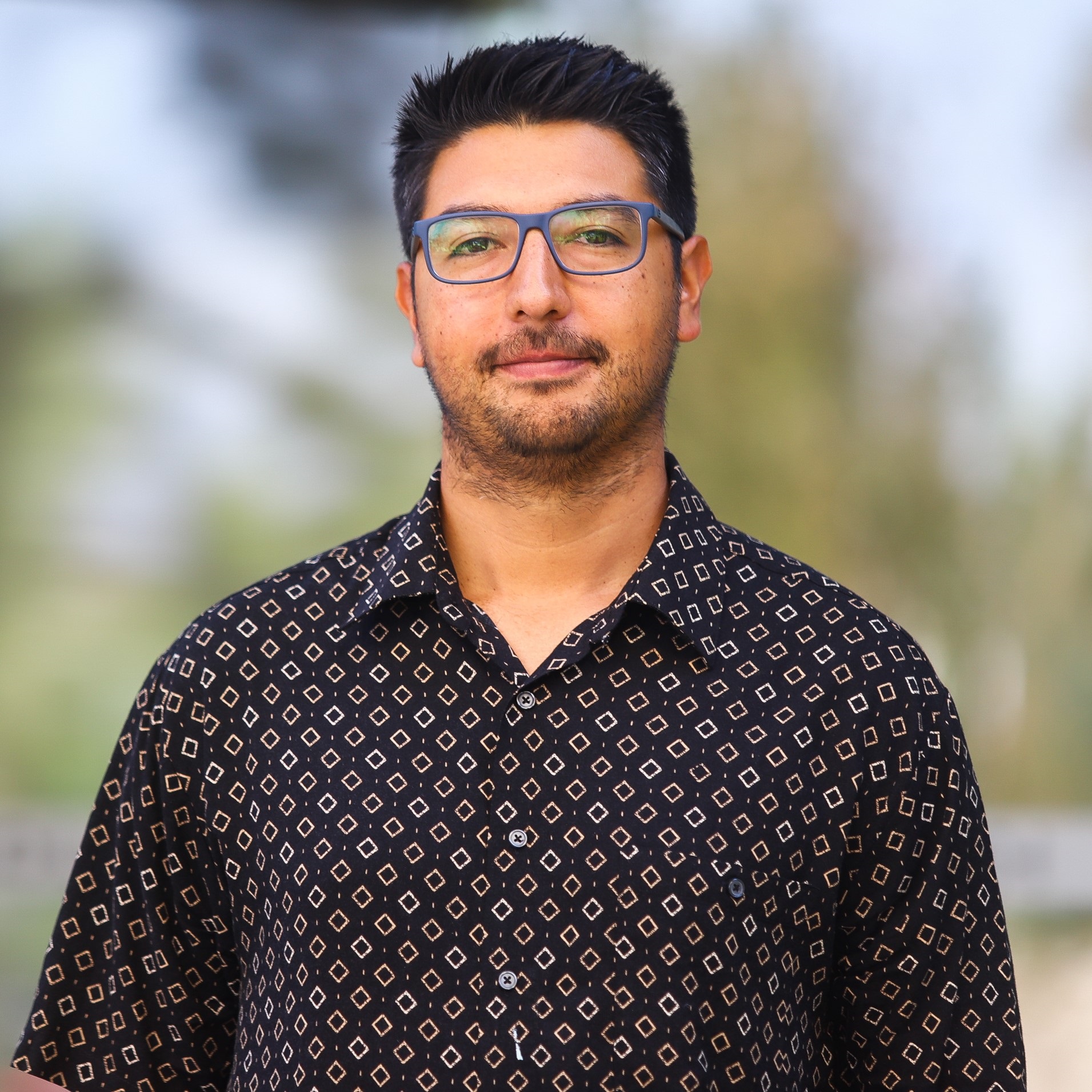
PhD en Cs Atmosféricas, Universidad de Colorado Boulder
Ingeniero en Recursos Naturales Renovables, Universidad de Chile
Descripción
Raúl se tituló de Ing. en Recursos Naturales Renovables en 2008. Posteriormente trabajó como profesional en la Dirección General de Aguas de Copiapó y como analista meteorológico en la empresa Ambimet. El año 2011 inicia sus estudios de Doctorado en Cs. Atmosféricas y Oceánicas en la Universidad de Colorado Boulder gracias a una beca proporcionada por el Gobierno de Chile (Becas Chile) y el programa Fulbright BIO de Estados Unidos. Durante su doctorado investigó la estructura de las corrientes de aire en las montañas costeras del norte de California y su relación con la precipitación orográfica utilizando un radar meteorológico en tierra y uno aerotransportado, obteniendo el grado de doctor en 2016. En 2017 regresa a Chile para continuar con un proyecto Fondecyt Postdoctoral en el cual estudió la relación entre Ríos Atmosféricos y lluvias extremas en la zona centro-sur de Chile. Se adjudica Fondecyt de Iniciación 2023 para estudiar la dinámica del vapor de agua, procesos de precipitación y rol de la convección en las lluvias extremas de Chile centro-sur.
12
8
1
1
- REVISTA Communications Earth & Environment
- 2024
South America rapidly becoming warmer, drier, and more flammable
• Sarah Feron • Raúl Cordero • Alessandro Damiani • Shelley MacDonell • Jaime Pizarro
- REVISTA Bulletin of the American Meteorological Society
- 2024
Towards a South American high impact weather reports database
• Paola Salio • Hernan Bechis • Bruno Ribeiro • Ernani de Lima Nascimento • Vito Galligani
- REVISTA Geophysical Research Letters
- 2024
Unraveling the Dynamics of Moisture Transport during Atmospheric Rivers Producing Rainfall in the Southern Andes
• Dipjyoti Mudiar • Roberto Rondanelli • Raúl Valenzuela • René D. Garreaud
- REVISTA Weather and Climate Extremes
- 2022
An extraordinary dry season precipitation event in the Subtropical Andes: Drivers, impacts and predictability
• Raúl Valenzuela • René Garreaud • Iván Vergara • Diego Campos • Maximiliano Viale
- REVISTA Bulletin of the American Meteorological Society
- 2022
Running a scientific conference during pandemic times
• Raúl Valenzuela • R. Garrreaud • Marty Ralph • A. Wilson • A. Ramos
- REVISTA Bulleting of the American Meteorological Society
- 2021
The Chilean Tornado Outbreak of May 2019:Synoptic, mesoscale, and historical context
• Jose Vicencio • Roberto Rondanelli • Diego Campos • Raúl Valenzuela • René Garreaud
- REVISTA Journal of Hydrometeorology
- 2019
Extreme Daily Rainfall in Central-Southern Chile and Its Relationship with Low-Level Horizontal Water Vapor Fluxes
• Raúl Valenzuela • René Garreaud
- REVISTA Journal of Hydrometeorology
- 2018
Impacts of Atmospheric Rivers on Precipitation in Southern South America
• Maximiliano Viale • Raúl Valenzuela • René Garreaud • Marty Ralph
- REVISTA Monthly Weather Review
- 2018
Terrain-Trapped Airflows and Orographic Rainfall along the Coast of Northern California. Part II: Horizontal and Vertical Structures Observed by a Scanning Doppler Radar
• Raúl Valenzuela • David Kingsmill
- REVISTA Journal of Hydrometeorology
- 2017
The Chilean Coastal Orographic Precipitation Experiment: Observing the Influence of Microphysical Rain Regimes on Coastal Orographic Precipitation
• Adam Massmann • Justin Minder • René Garreaud • David Kingsmill • Raúl Valenzuela
- REVISTA Monthly Weather Review
- 2017
Terrain-Trapped Airflows and Orographic Rainfall along the Coast of Northern California. Part I: Kinematic Characterization Using a Wind Profiling Radar
• Raúl Valenzuela • David Kingsmill
- REVISTA Monthly Weather Review
- 2015
Orographic Precipitation Forcing along the Coast of Northern California during a Landfalling Winter Storm
• Raúl Valenzuela • David Kingsmill
- CP21-P134
- Noviembre 2024 - Octubre 2016
Microplásticos en material particulado en la Región de OHiggins: evaluando su presencia, exposición e interacción con elementos potencialmente tóxicos
- Fondecyt de Iniciación 11230184
- Marzo 2023 - Marzo 2025
Fondecyt de Iniciación 11230184 Atmospheric water vapor and precipitation processes in central and southern Chile
- ACT210046
- Marzo 2022 - Marzo 2024
Compound and Cascading Climate Extremes in Chile
- ACT210046
- Enero 2022 - Diciembre 2024
Sistema Articulado de Investigación en Cambio Climático y Sustentabilidad de Zonas Costeras de Chile (URO RED21992)
- CP21-P134
- Enero 2022 - Diciembre 2022
Volando en El Tiempo
- CP21-P134
- Marzo 2017 - Febrero 2020
Atmospheric Rivers in the Southeastern Pacific and Their Impact on Extreme Orographic Precipitation
- CP21-P134
- Mayo 2015 - Agosto 2015
The Chilean Coastal Orographic Precipitation Experiment (CCOPE)
- CP21-P134
- Agosto 2012 - Octubre 2016
Coastal orographic precipitation process studies
- Chile -
Cultivos energéticos una apuesta de futuro
- 2020
Global and Regional Perspectives
raul.valenzuela@uoh.cl
Pablo Gutiérrez ● Profesor Asociado
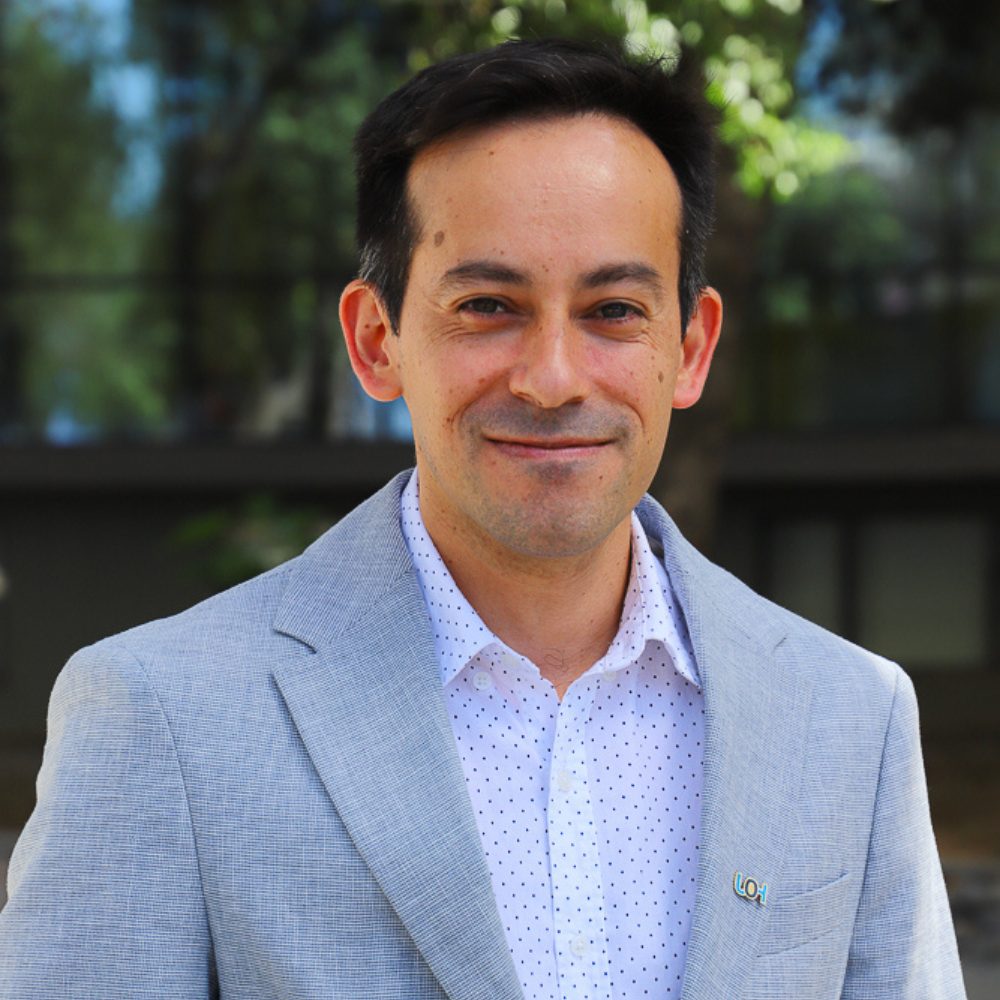
Doctor en Física, École Polytechnique, Francia, 2013.,Magister en Ciencias, mención Física, Universidad de Chile, 2007.
Licenciado en Ciencias, mención Física.
Descripción
Pablo Gutiérrez es uno de los académicos pioneros del Instituto de Ciencias de la Ingeniería. Se formó como físico, primero en la Universidad de Chile y luego en Francia. Realiza investigación fuertemente motivada por la curiosidad y la estética. Así, se ha especializado en mecánica de fluidos, medios granulares y física no-lineal, estudiando particularmente flujos en superficie libre, interacción fluido estructura y flujos medio-ambientales. Generalmente aborda su investigación mediante experimentos de “tamaño escritorio”, o modelos matemáticos sencillos. Realiza docencia en la Escuela de Ingeniería y actualmente es Director del Instituto de Ciencias de la Ingeniería.
Pablo desarrolla investigación en la área del Instituto de Física, Mecánica y Materiales.
15
5
- REVISTA Physical Review E
- 2023
Stability of a tilted granular monolayer: How many spheres can we pick before the collapse?
• Eduardo Rojas Parra • Héctor Alarcón • Vicente Salinas • Gustavo Castillo Bautista • Pablo Gutierrez Matus
- REVISTA Physical Review Letters
- 2023
Swirling fluid reduces the bounce of partially filled containers
• Klebbert Andrade • Javiera Catalán • Juan Marín • Vicente Salinas • Gustavo Castillo Bautista
- REVISTA Physical Review E
- 2023
Stability of a tilted granular monolayer: How many spheres can we pick before the collapse?
• Eduardo Rojas Parra • Héctor Alarcón • Vicente Salinas • Gustavo Castillo Bautista • Pablo Gutierrez Matus
- REVISTA Physical Review Letters
- 2023
Swirling fluid reduces the bounce of partially filled containers
• Klebbert Andrade • Javiera Catalán • Juan Marín • Vicente Salinas • Gustavo Castillo Bautista
- REVISTA Nature Communications
- 2022
Stress distribution and surface shock wave of drop impact
• Ting-Pi Sun • Franco Alvarez-Novoa • Klebbert Andrade • Pablo Gutierrez Matus • Leonardo Gordillo
- REVISTA Nature Communications
- 2022
Stress distribution and surface shock wave of drop impact
• Ting-Pi Sun • Franco Alvarez-Novoa • Klebbert Andrade • Pablo Gutierrez Matus • Leonardo Gordillo
- REVISTA Physical Review Letters
- 2020
Faraday-waves contact-line shear gradient induces streaming and tracer self-organization: From vortical to hedgehoglike patterns
• Héctor Alarcón • Matías Herrera • Nicolas Périnet • Nicolás Mujica • Pablo Gutierrez Matus
- REVISTA Physical Review Letters
- 2020
Faraday-waves contact-line shear gradient induces streaming and tracer self-organization: From vortical to hedgehoglike patterns
• Héctor Alarcón • Matías Herrera • Nicolas Périnet • Nicolás Mujica • Pablo Gutierrez Matus
- REVISTA Journal of Fluid Mechanics
- 2017
Streaming patterns in Faraday waves
• Nicolas Périnet • Pablo Gutierrez Matus • Hector Urra • Nicolás Mujica • Leonardo Gordillo
- REVISTA Journal of Fluid Mechanics
- 2017
Streaming patterns in Faraday waves
• Nicolas Périnet • Pablo Gutierrez Matus • Hector Urra • Nicolás Mujica • Leonardo Gordillo
- REVISTA European Journal of Mechanics - B/Fluids
- 2016
Clustering of floaters on the free surface of a turbulent flow: An experimental study
• Pablo Gutierrez Matus • Sébastien Aumaître
- REVISTA Physics of Fluids
- 2016
Surface waves propagating on a turbulent flow
• Pablo Gutierrez Matus • Sébastien Aumaître
- REVISTA European Journal of Mechanics - B/Fluids
- 2016
Clustering of floaters on the free surface of a turbulent flow: An experimental study
• Pablo Gutierrez Matus • Sébastien Aumaître
- REVISTA Physics of Fluids
- 2016
Surface waves propagating on a turbulent flow
• Pablo Gutierrez Matus • Sébastien Aumaître
- REVISTA Springer Proceedings in Physics
- 2015
Measurements of Surface Deformation in Highly-Reflecting Liquid-Metals
• Pablo Gutierrez Matus • Vincent Padilla • Sébastien Aumaître
- REVISTA Journal of Fluid Mechanics
- 2015
Role of the basin boundary conditions in gravity wave turbulence
• Luc Deike • Benjamin Miquel • Pablo Gutierrez Matus • Timotee Jamin • Benoît Semin
- REVISTA Physical Review E
- 2015
Statistics of injected power on a bouncing ball subjected to a randomly vibrating piston
• Alfredo García-Cid • Pablo Gutierrez Matus • Claudio Falcón • Sébastien Aumaître • Eric Falcon
- REVISTA Springer Proceedings in Physics
- 2015
Measurements of Surface Deformation in Highly-Reflecting Liquid-Metals
• Pablo Gutierrez Matus • Vincent Padilla • Sébastien Aumaître
- REVISTA Journal of Fluid Mechanics
- 2015
Role of the basin boundary conditions in gravity wave turbulence
• Luc Deike • Benjamin Miquel • Pablo Gutierrez Matus • Timotee Jamin • Benoît Semin
- REVISTA Physical Review E
- 2015
Statistics of injected power on a bouncing ball subjected to a randomly vibrating piston
• Alfredo García-Cid • Pablo Gutierrez Matus • Claudio Falcón • Sébastien Aumaître • Eric Falcon
- REVISTA Physical Review E
- 2013
Phase transition in an out-of-equilibrium monolayer of dipolar vibrated grains
• Loreto Oyarte • Pablo Gutierrez Matus • Sébastien Aumaître • Nicolás Mujica
- REVISTA Physical Review E
- 2013
Phase transition in an out-of-equilibrium monolayer of dipolar vibrated grains
• Loreto Oyarte • Pablo Gutierrez Matus • Sébastien Aumaître • Nicolás Mujica
- REVISTA Philosophical Transactions of the Royal Society A: Mathematical, Physical and Engineering Sciences
- 2009
Transition from pulses to fronts in the cubic-quintic complex Ginzburg-Landau equation
• Pablo Gutierrez Matus • Daniel Escaff • Orazio Descalzi
- REVISTA Physical Review E
- 2009
Moving breathing pulses in the one-dimensional complex cubic-quintic Ginzburg-Landau equation
• Pablo Gutierrez Matus • Daniel Escaff • Santiago Pérez-Oyarzún • Orazio Descalzi
- REVISTA Philosophical Transactions of the Royal Society A: Mathematical, Physical and Engineering Sciences
- 2009
Transition from pulses to fronts in the cubic-quintic complex Ginzburg-Landau equation
• Pablo Gutierrez Matus • Daniel Escaff • Orazio Descalzi
- REVISTA Physical Review E
- 2009
Moving breathing pulses in the one-dimensional complex cubic-quintic Ginzburg-Landau equation
• Pablo Gutierrez Matus • Daniel Escaff • Santiago Pérez-Oyarzún • Orazio Descalzi
- REVISTA The European Physical Journal Special Topics
- 2007
Collisions of counter-propagating pulses in coupled complex cubic-quintic Ginzburg-Landau equations
• Orazio Descalzi • Jaime Cisternas • Pablo Gutierrez Matus • Helmut Brand
- REVISTA The European Physical Journal Special Topics
- 2007
Collisions of counter-propagating pulses in coupled complex cubic-quintic Ginzburg-Landau equations
• Orazio Descalzi • Jaime Cisternas • Pablo Gutierrez Matus • Helmut Brand
- REVISTA International Journal of Modern Physics C
- 2006
LOCALIZED STRUCTURES IN NONEQUILIBRIUM SYSTEMS
• Orazio Descalzi • Pablo Gutierrez Matus • Enrique Tirapegui
- REVISTA International Journal of Modern Physics C
- 2006
LOCALIZED STRUCTURES IN NONEQUILIBRIUM SYSTEMS
• Orazio Descalzi • Pablo Gutierrez Matus • Enrique Tirapegui
- IDI40048446-0
- Marzo 2023 - Febrero 2026
Fabricación digital para Jóvenes Makers
- IDI40048446-0
- Marzo 2023 - Febrero 2026
Fabricación digital para Jóvenes Makers
- IDI40048446-0
- Abril 2020 - Febrero 2022
Image Modeling and Processing for REmote SenSing in agriculture (IMPRESS)
- IDI40048446-0
- Abril 2020 - Septiembre 2022
Transferencia Fábrica Digital de la Sexta
- IDI40048446-0
- Abril 2020 - Febrero 2022
Image Modeling and Processing for REmote SenSing in agriculture (IMPRESS)
- IDI40048446-0
- Abril 2020 - Septiembre 2022
Transferencia Fábrica Digital de la Sexta
- IDI40048446-0
- Noviembre 2019 - Octubre 2023
Experiments on Fluid Impact: the example of bottleflip challenge
- IDI40048446-0
- Noviembre 2019 - Octubre 2023
Experiments on Fluid Impact: the example of bottleflip challenge
- IDI40048446-0
- Octubre 2018 - Noviembre 2021
Desarrollo de un sistema público de alerta temprana para proveer de avisos de aplicación oportunos para el control de Eulias en frutales y viñas
- IDI40048446-0
- Octubre 2018 - Noviembre 2021